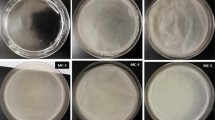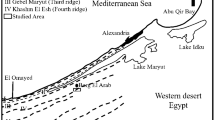Abstract
Different materials in form of sponge, hydrogel and film have been developed and formulated for treating and dressing burn wounds. In this study, the potential of Laponite, a gel forming clay, in combination with an antimicrobial agent (mafenide), as a wound dressing material was tested in vitro. Laponite/mafenide (Lap/Maf) hydrogel was formulated in three different ratios of Lap/Maf 1:1, 1:2, 1:3. Laponite/mafenide/alginate (Lap/Maf/Alg) film was also formulated by combining Lap/Maf gel (1:1) with alginate. Intercalation rate of mafenide into the layers of Laponite nanoparticles and physico-chemical properties, including wound dressing characteristics of materials were studied using various analytical methods. Furthermore, the degradation of materials and the release profile of mafenide were investigated in simulated wound exudates fluid and antibacterial effectiveness of the eluted mafenide was tested on a range of bacterial species. The cytotoxicity of materials was also evaluated in skin fibroblast culture. The results showed that mafenide molecules were intercalated between the nano-sized layers of Laponite. The eluted mafenide showed active antibacterial effects against all three tested bacteria. All intercalated mafenide released from Lap/Maf 1:1 and 1:2 gel formulations and nearly 80 % release from 1:3 formulation during test period. No significant difference was observed in release profile of mafenide between Lap/Maf/Alg film and Lap/Maf formulations. Wound dressing tests on Lap/Maf/Alg film showed it is a breathable dressing and has capacity to absorb wound exudates. The study showed that prepared Lap/Maf composite has the potential to be used as an antibiotic eluting gel or film for wound healing application. Additionally, Laponite has shown benefits in wound healing processes by releasing Mg2+ ions and thereby reducing the cytotoxic effect of mafenide on fibroblast cells.






Similar content being viewed by others
References
Connolly S (2012) in Service ASBI (ed) Agency For Clinical Innovation Australia.
Zhu XB, Chang XJ, Cui YM, Zou XJ, Yang D, Hu Z. Solid-phase extraction of trace Cu(II) Fe(III) and Zn(II) with silica gel modified with curcumin from biological and natural water samples by ICP-OES. Microchem J. 2007;86:189–94.
Moncrief JA, Lindberg RB, Switzer WE, Fruitt BA. The use of a topical sulfonamide in the control of burn wound sepsis. J Trauma Injury Infect Crit Care. 1966;6:407–19.
Falcone PA, Harrison HN, Sowemimo GO, Reading GP. Mafenide acetate concentrations and bacteriostasis in experimental burn wounds treated with a three-layered laminated mafenide–saline dressing. Ann Plast Surg. 1980;5:266–9.
Dash AK, Saha S. Analytical profiles of drug substances and excipients, vol. 24. San Diego: Academic Press; 1996. p. 277–305.
United States Pharmacopeia and National Formulary (USP-NF). Encyclopedia of global health. Thousand Oaks: SAGE; 2008.
Lee J, Marvin J, Heimbach D, Grube B. Use of 5% sulfamylon (mafenide) solution after excision and grafting of burns. J Burn Care Rehabil. 1988;9:602–5.
Harrison HN, Shuck JM, Caldwell E. Studies of the pain produced by mafenide acetate preparations in burns. Arch Surg. 1975;110:1446–9.
White MG, Asch MJ. Acid–base effects of topical mafenide acetate in the burned patient. N Engl J Med. 1971;284:1281–6.
McCauley RL, Li Y–Y, Poole B, et al. Differential inhibition of human basal keratinocyte growth to silver sulfadiazine and mafenide acetate. J Surg Res. 1992;52:276–85.
McCauley RL, Linares HA, Pelligrini V, Herndon DN, Robson MC, Heggers JP. In vitro toxicity of topical antimicrobial agents to human fibroblasts. J Surg Res. 1989;46:267–74.
Erdmann D, Hussmann J, Kucan JO. Treatment of a severe alkali burn. Burns. 1996;22:141–6.
Aguzzi C, Cerezo P, Viseras C, Caramella C. Use of clays as drug delivery systems: possibilities and limitations. Appl Clay Sci. 2007;36:22–36.
Betty KR, Day GT. Spectrophotometric determination of boron in nuclear-grade uranium-oxides with curcumin after extraction with 2-ethylhexane-1,3-diol. Analyst. 1986;111:455–7.
Li Z, Chang P-H, Jiang W-T, Jean J-S, Hong H. Mechanism of methylene blue removal from water by swelling clays. Chem Eng J. 2011;168:1193–200.
Viseras C, Aguzzi C, Cerezo P, Lopez-Galindo A. Uses of clay minerals in semisolid health care and therapeutic products. Appl Clay Sci. 2007;36:37–50.
Sinha Ray S, Okamoto M. Polymer/layered silicate nanocomposites: a review from preparation to processing. Prog Polym Sci. 2003;28:1539–641.
Ghadiri M, Hau H, Chrzanowski W, Agus H, Rohanizadeh R. Laponite clay as a carrier for in situ delivery of tetracycline. RSC Advances. 2013;3(43):20193–201.
Sagert KB, United States Pharmacopeia and National Formulary (USP-NF). Encyclopedia of global health. SAGE Publications, Thousand Oaks.
Jorgensen JH, Ferraro MJ. Antimicrobial susceptibility testing: a review of general principles and contemporary practices. Clin Infect Dis. 2009;49:1749–55.
Bippus L, Jaber M, Lebeau B. Laponite and hybrid surfactant/laponite particles processed as spheres by spray-drying. New J Chem. 2009;33:1116–26.
Wesolowski M, Kosecka E, Erecinska J, Kobylczyk K. The influence of chemical structure of sulfonamides on the course of their thermal decomposition. J Therm Anal Calorim. 2003;74:465–76.
Dumville JC, O’Meara S, Deshpande S, Speak K. Alginate dressings for healing diabetic foot ulcers. Cochrane Database Syst Rev. 2013;7:CD009101.
Li ZH, Kolb VM, Jiang WT, Hong HL. Ftir and Xrd investigations of tetracycline intercalation in smectites. Clays Clay Miner. 2010;58:462–74.
Elsner JJ, Zilberman M. Antibiotic-eluting bioresorbable composite fibers for wound healing applications: microstructure, drug delivery and mechanical properties. Acta Biomater. 2009;5:2872–83.
Makhmalzadeh BS. Preparation and evaluation of mafenide acetate liposomal formulation as eschar delivery system. Int J Drug Dev Res. 2011;3:129–40.
Tamimi F, Torres J, Bettini R, et al. Doxycycline sustained release from brushite cements for the treatment of periodontal diseases. J Biomed Mater Res Part A. 2008;85A:707–14.
Ghadiri M, Hau H, Chrzanowski W, Agus H, Rohanizadeh R. Laponite clay as a carrier for in situ delivery of tetracycline. RSC Adv. 2013;3:20193–201.
Jung H, Kim H-M, Choy YB, Hwang S-J, Choy J-H. Itraconazole–Laponite: kinetics and mechanism of drug release. Appl Clay Sci. 2008;40:99–107.
Kumar P, Jasra RV, Bhat TSG. Evolution of porosity and surface acidity in montmorillonite clay on acid activation. Ind Eng Chem Res. 1995;34:1440–8.
Woolf CJ, Mannion RJ. Neuropathic pain: aetiology, symptoms, mechanisms, and management. Lancet. 1999;353:1959–64.
Grzesiak JJ, Pierschbacher MD. Shifts in the concentrations of magnesium and calcium in early porcine and rat wound fluids activate the cell migratory response. J Clin Investig. 1995;95:227–33.
Wang C–C, Juang L-C, Lee C-K, Hsu T-C, Lee J-F, Chao H-P. Effects of exchanged surfactant cations on the pore structure and adsorption characteristics of montmorillonite. J Colloid Interface Sci. 2004;280:27–35.
Oh ST, Kim WR, Kim SH, Chung YC, Park JS. The preparation of polyurethane foam combined with pH-sensitive alginate/bentonite hydrogel for wound dressings. Fibers Polymers. 2011;12:159–65.
Sirousazar M, Kokabi M, Hassan ZM. Swelling behavior and structural characteristics of polyvinyl alcohol/montmorillonite nanocomposite hydrogels. J Appl Polym Sci. 2012;123:50–8.
Sirousazar M, Kokabi M, Hassan ZM, Bahramian AR. Dehydration kinetics of polyvinyl alcohol nanocomposite hydrogels containing Na-montmorillonite nanoclay. Sci Iran. 2011;18:780–4.
Gorrasi G, Pantani R, Murariu M, Dubois P. PLA/halloysite nanocomposite films: water vapor barrier properties and specific key characteristics. Macromol Mater Eng. 2014;299:104–15.
Glasser JS, Guymon CH, Mende K, Wolf SE, Hospenthal DR, Murray CK. Activity of topical antimicrobial agents against multidrug-resistant bacteria recovered from burn patients. Burns. 2010;36:1172–84.
Holder IAP. Wet disc testing of mafenide hydrochloride chlorhexidine gluconate, and triple antibiotic solution against bacteria isolated from burn wounds. J Burn Care Rehabil. 1990;11:301–4.
Hemmila MR, Mattar A, Taddonio MA, et al. Topical nanoemulsion therapy reduces bacterial wound infection and inflammation after burn injury. Surgery. 2010;148:499–509.
Zreiqat H, Howlett CR, Zannettino A, et al. Mechanisms of magnesium-stimulated adhesion of osteoblastic cells to commonly used orthopaedic implants. J Biomed Mater Res. 2002;62:175–84.
Cooper ML, Boyce ST, Hansbrough JF, Foreman TJ, Frank DH. Cytotoxicity to cultured human keratinocytes of topical antimicrobial agents. J Surg Res. 1990;48:190–5.
Acknowledgments
Authors acknowledge the facilities, and the scientific and technical assistance, of the Australian Microscopy and Microanalysis Research Facility at the Australian Centre for Microscopy and Microanalysis, University of Sydney. Authors would like to thank A/Prof Fariba Dehghani from the School of Chemical and Biomolecular Engineering, The University of Sydney for assisting in FTIR analysis. We appreciate Prof Brendan Kennedy’s help from The Department of chemistry, The University of Sydney, for allowing us to use XRD and all his scientific advices in this regard.
Author information
Authors and Affiliations
Corresponding author
Rights and permissions
About this article
Cite this article
Ghadiri, M., Chrzanowski, W. & Rohanizadeh, R. Antibiotic eluting clay mineral (Laponite®) for wound healing application: an in vitro study. J Mater Sci: Mater Med 25, 2513–2526 (2014). https://doi.org/10.1007/s10856-014-5272-7
Received:
Accepted:
Published:
Issue Date:
DOI: https://doi.org/10.1007/s10856-014-5272-7




